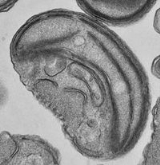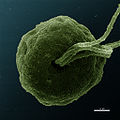
Prasinophyceae
Encyclopedia
In taxonomy
, Prasinophytes are a class of the Division Chlorophyta
. These are primitive eukaryotic, marine green algae
. Its best known genus is Ostreococcus
(seen at right), which is considered to be the smallest (ca. 0.95 μm
) free-living eukaryote
and which has been detected in marine samples around the world. Prasinophytes are thought to have low cellular complexity, that is, they are naked cells that possess single, multiple or no flagellae and contain only a single chloroplast
and a single mitochondrion
. They also have very small genomes for a eukaryote (about 12Mbp).
Recent studies agree that the prasinophytes are not a natural group, being highly paraphyletic
. Alternative classifications of the chlorophytes have been proposed in which this class is replaced by at least six separate taxa.

 A study of photosynthetic gene-sequence diversity (rbcL) in the Gulf of Mexico
A study of photosynthetic gene-sequence diversity (rbcL) in the Gulf of Mexico
indicated that Prasinophytes are particularly prevalent at the Subsurface Chlorophyll Maximum (SCM) and several different ecotypes of Ostreococcus have been detected in the environment. These ecotypes are distinguished by their adaptation to light intensities. O. lucimarinus is found in high-light environments and represents surface-isolated strains. RCC141 is considered low-light, because these strains were isolated from the lower euphotic zone. O. tauri was isolated from a coastal lagoon and is considered light-polyvalent. Genetic data indicates that distinct molecular differences exist between the different ecotypes that have been detected.
. Relationships among the groups making up the chlorophytes are not fully resolved. The cladogram
produced by Becker and Marin in 2009 is shown below. The blue shaded groups are all prasinophytes. The prasinophyte species Mesostigma
viride has been shown to be a member of the Streptophyta rather than the Chlorophyta, so is not included in this cladogram.
Alpha taxonomy
Alpha taxonomy is the discipline concerned with finding, describing and naming species of living or fossil organisms. This field is supported by institutions holding collections of these organisms, with relevant data, carefully curated: such institutes include natural history museums, herbaria and...
, Prasinophytes are a class of the Division Chlorophyta
Chlorophyta
Chlorophyta is a division of green algae, informally called chlorophytes. The name is used in two very different senses so that care is needed to determine the use by a particular author...
. These are primitive eukaryotic, marine green algae
Green algae
The green algae are the large group of algae from which the embryophytes emerged. As such, they form a paraphyletic group, although the group including both green algae and embryophytes is monophyletic...
. Its best known genus is Ostreococcus
Ostreococcus
Ostreococcus is a genus of unicellular coccoid or spherically shaped green alga belonging to the class Prasinophyceae. It includes prominent members of the global picoplankton community, which plays a central role in the oceanic carbon cycle.-History:...
(seen at right), which is considered to be the smallest (ca. 0.95 μm
Micrometre
A micrometer , is by definition 1×10-6 of a meter .In plain English, it means one-millionth of a meter . Its unit symbol in the International System of Units is μm...
) free-living eukaryote
Eukaryote
A eukaryote is an organism whose cells contain complex structures enclosed within membranes. Eukaryotes may more formally be referred to as the taxon Eukarya or Eukaryota. The defining membrane-bound structure that sets eukaryotic cells apart from prokaryotic cells is the nucleus, or nuclear...
and which has been detected in marine samples around the world. Prasinophytes are thought to have low cellular complexity, that is, they are naked cells that possess single, multiple or no flagellae and contain only a single chloroplast
Chloroplast
Chloroplasts are organelles found in plant cells and other eukaryotic organisms that conduct photosynthesis. Chloroplasts capture light energy to conserve free energy in the form of ATP and reduce NADP to NADPH through a complex set of processes called photosynthesis.Chloroplasts are green...
and a single mitochondrion
Mitochondrion
In cell biology, a mitochondrion is a membrane-enclosed organelle found in most eukaryotic cells. These organelles range from 0.5 to 1.0 micrometers in diameter...
. They also have very small genomes for a eukaryote (about 12Mbp).
Recent studies agree that the prasinophytes are not a natural group, being highly paraphyletic
Paraphyly
A group of taxa is said to be paraphyletic if the group consists of all the descendants of a hypothetical closest common ancestor minus one or more monophyletic groups of descendants...
. Alternative classifications of the chlorophytes have been proposed in which this class is replaced by at least six separate taxa.
Ecology


Gulf of Mexico
The Gulf of Mexico is a partially landlocked ocean basin largely surrounded by the North American continent and the island of Cuba. It is bounded on the northeast, north and northwest by the Gulf Coast of the United States, on the southwest and south by Mexico, and on the southeast by Cuba. In...
indicated that Prasinophytes are particularly prevalent at the Subsurface Chlorophyll Maximum (SCM) and several different ecotypes of Ostreococcus have been detected in the environment. These ecotypes are distinguished by their adaptation to light intensities. O. lucimarinus is found in high-light environments and represents surface-isolated strains. RCC141 is considered low-light, because these strains were isolated from the lower euphotic zone. O. tauri was isolated from a coastal lagoon and is considered light-polyvalent. Genetic data indicates that distinct molecular differences exist between the different ecotypes that have been detected.
Phylogeny
Recent studies agree that the prasinophytes are not a natural group, being highly paraphyleticParaphyly
A group of taxa is said to be paraphyletic if the group consists of all the descendants of a hypothetical closest common ancestor minus one or more monophyletic groups of descendants...
. Relationships among the groups making up the chlorophytes are not fully resolved. The cladogram
Cladogram
A cladogram is a diagram used in cladistics which shows ancestral relations between organisms, to represent the evolutionary tree of life. Although traditionally such cladograms were generated largely on the basis of morphological characters, DNA and RNA sequencing data and computational...
produced by Becker and Marin in 2009 is shown below. The blue shaded groups are all prasinophytes. The prasinophyte species Mesostigma
Mesostigma
Mesostigma viride is a species of freshwater green algae. It is now considered to be one of the earliest diverging members of the Streptophyta, one of the two lineages of green plants ....
viride has been shown to be a member of the Streptophyta rather than the Chlorophyta, so is not included in this cladogram.

